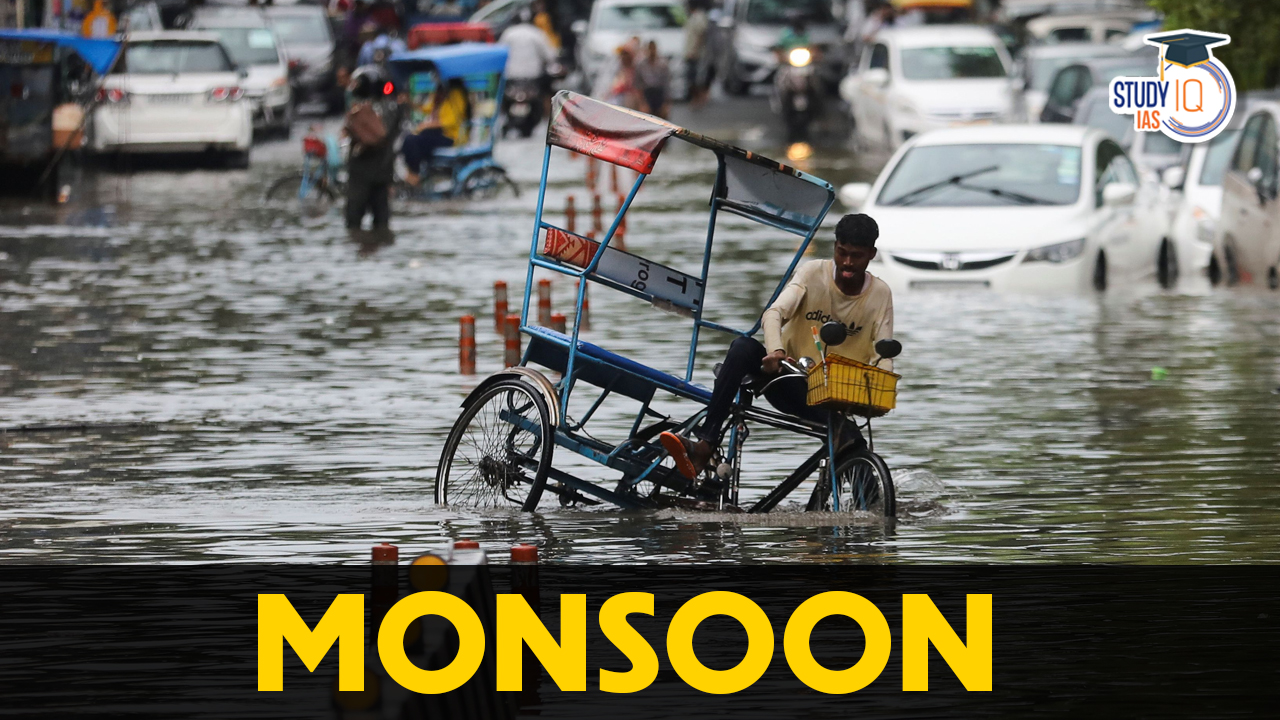Table of Contents
Context: The state of Kerala has been taking precautionary measures to deal with the upcoming southwest monsoon.
What is Monsoon?
- A monsoon is a seasonal reversal of winds that brings moisture-laden winds to the Indian sub-continent, causing rainfall.
- It can also be described as seasonal changes in atmospheric circulation and precipitation due to annual latitudinal oscillation of the Inter Tropical Convergence Zone (ITCZ) between the north and south of the equator.
- Features of monsoon:
- Dry spell and wet spell: Monsoon in India has clearly marked wet phase and dry phase, characterized by weeks where there is no rainfall.
- Unequal distribution: Monsoon rains are unequally distributed with the peninsular part of India receiving more rainfall than the plains.
- Topographic influence: Monsoons are influenced by topography. The Western side of the Western Ghats receives heavy rainfall whereas the eastern side is deficient.
- Fixed schedule: Monsoons in India have typically a fixed schedule. It usually begins by June’s first week and ends by September.
Conditions Influencing Monsoon
- Mascarene high: The presence of this high-pressure area near Madagascar helps in the dispersal of moisture-laden winds towards the Indian sub-continent.
- Low pressure on the Tibetan plateau: During summers, the Tibetan plateau gets immensely heated, thereby creating a low-pressure area that attracts trade winds.
- Northward shift of Inter-tropical convergence zone (ITCZ): The northward shift of ITCZ over north and northwest India creates a low-pressure area known as a monsoon trough.
- Differential cooling of land and sea: Differential cooling generates a low pressure on the landmass of India while surrounding seas experience comparatively high pressure.
- Shift of westerly Jet Stream: This shift to the north of the Himalayas creates the requisite temperature for the arrival of monsoonal winds.
- Southern Oscillation: El Nino or La Nina conditions either strengthen or weaken the Indian monsoons depending on their occurrence.
Mechanism of Monsoon
- During summer, the northward shift of ITCZ helps develop a low-pressure area over interior Asia as well as north and north-western India.
- A high-pressure system over the southern Indian Ocean develops at the same time.
- The low-pressure system over the Indian landmass attracts the southeast trade winds of the southern hemisphere, which turn right towards the low-pressure areas over the Indian subcontinent as a result of the Coriolis force.
- These south-westerly blowing winds enter the Indian peninsula as the southwest monsoon. Since they blow over warm oceans, they bring abundant moisture to the subcontinent.
- After 100 to 120 days, the low-pressure system over north and north-west India weakens due to the southern shift of ITCZ. This leads to the retreat of the monsoon winds.

Monsoon in India
- South-west monsoon:
- The south-west monsoon in India is divided into two parts—the Arabian Sea branch and the Bay of Bengal branch.
- The Arabian Sea branch causes orographic rainfall along the western slopes of the Western Ghats from the coast of Kerala to Gujarat.
- The Bay of Bengal branch moves over the Bay of Bengal, collecting moisture on the way, and strikes the northeastern part of India.
- The Eastern Himalayas divert the winds towards the Indo-Gangetic Plains. The entry into the plains marks the onset of monsoon.
- North-east monsoon:
- As Sun starts moving towards the southern hemisphere, a change in pressure conditions causes the cold wind to sweep down from the Himalayas and Indo-Gangetic Plain towards the Indian Ocean.
- On its way, the cold dry wind picks up some moisture from the Bay of Bengal and pours it over the eastern part of peninsular India. This is called the northeast monsoon.

Significance of Monsoon for India
- Source of water: The monsoon accounts for nearly 80% of the rainfall in India. It is responsible for replenishing the depleted water resources of the country.
- Irrigation: The majority of India is dependent on monsoon rainfall for irrigating their crops. This makes it critical for India’s food security.
- Economy: India is primarily an agro-economy with the vast majority depending on agriculture for their livelihoods. Delays in monsoons can hamper economic growth and can have a domino effect.
- Sustain flora and fauna: Vast biodiversity in India is supported by rains caused during the monsoon season. Monsoons are responsible for maintaining ecological balance.
Current Trends in Indian Monsoon
- Monsoons are showing lesser rainy days and more extreme precipitation, indicating an unpredictable pattern.
- Dry spells and excessive rains have combined to impact the output of Kharif crops, thereby putting stress on food security.
- The impact of unpredictable monsoons and heatwaves on food grains is one of the clearest evidence of climate change that can pose challenges for policymakers, animal breeders and farmers,


 Daily Quiz 11 July 2025
Daily Quiz 11 July 2025
 Operation Baam: Baloch Separatist Group ...
Operation Baam: Baloch Separatist Group ...
 Article 326 and Electoral Roll Revision ...
Article 326 and Electoral Roll Revision ...





















